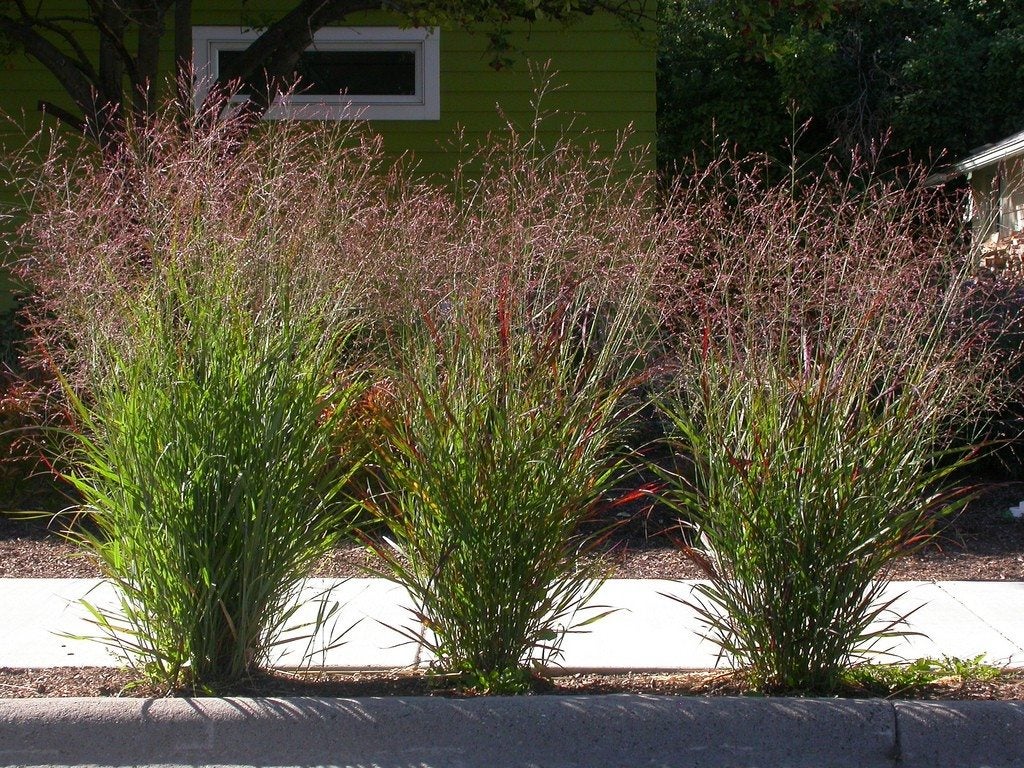Growing Switchgrass - How To Plant Switchgrass


Switchgrass (Panicum virgatum) is an upright prairie grass that produces feathery delicate flowers from July to September. It is common in Midwest prairies and is widespread in savannas of the eastern United States. There are several switchgrass varieties to choose from and its high tolerance for different planting sites makes ornamental switchgrass a great choice for any landscape. Providing height, flow, and drama, planting switchgrass brings it all to the decorative garden.
What is Ornamental Switchgrass?
This clumping grass may grow 4 to 6 feet (1-2 m.) tall. It has fine bladed foliage and produces a feathery inflorescence in late summer, which may be deep red or purple. The flower plume will persist well into fall and bears glossy red seeds. The foliage is bluish green most of the time and produces a haze of soft color in the landscape. Switchgrass is a perennial plant that has incredible versatility and hardiness, growing well in USDA zones 5 to 9.
Switchgrass Varieties
Successful ornamental plants undergo breeding and development to increase desirable characteristics and minimize problems. There are several cultivars available:
- Cloud Nine and North Wind are 5 to 6 foot (1.5-2 m.) tall specimens.
- Dallas Blues is the tallest variety at 6 to 8 feet (around 2 m.) in height and has a blue to purple foliage with seed heads 2 inches (5 cm.) long.
- Heavy Metal is a rigid plant with metallic blue blades.
- Shenandoah is the smallest of the switchgrass varieties at a diminutive 2 to 3 feet (61-91 cm.) tall.
- Rotstrahlbush and Warrior are just a couple of several other cultivars to consider for your garden.
How to Plant Switchgrass
When planting switchgrass, consider the height of the grass and place it to the rear or edges of a garden bed so it doesn't cover up smaller plants. The spread is also a consideration, but as a clumping variety, switchgrass is never more than half as wide as it is tall. Plant switchgrass in a group spaced at least 12 inches (31 cm.) apart and they will grow together to make an interesting moving screen. Before planting switchgrass, the site should be well cultivated to accommodate the long taproot, which will eventually grow 10 feet (3 m.) long or more. The mature size may lead the gardener to wonder will switchgrass grow in pots. The answer would be yes and no. Young plants are ideal for container interest, but the thick rhizomes will fill small pots quickly. Mature specimens will require a large, heavy, deep pot. You will also need to give the grass more water when potted than ground planted specimens. This plant enjoys full sun to partial shade. It is tolerant of salt exposure and short periods of drought. You can plant switchgrass in moderately moist soil or even dry conditions. Switchgrass thrives in sand, clay, or loam soil. The soil does need to be well drained and have minimum nutrient levels. That being said, it is always a good idea to incorporate organic matter to the planting hole, such as compost. Switchgrass is set into the ground at the same level it was grown in the nursery pot. The plant will seed vigorously and you might find babies in your yard. It is suggested to mulch thickly to prevent seedlings or remove the flower heads.
Care of Switchgrass
As a native species, the plant is well suited to growing wild and does not need any special supplemental care. You may incorporate fertilizing in early spring but is really only necessary on the poorest soils. Remove all competing plant and weed species, and provide organic mulch around the base of the plant. This will conserve moisture, prevent further weeds, and gradually enrich the soil. Switchgrass may die back in winter but the rhizome will remain alive underground, especially if the plants are mulched. You can divide the plant every few years to produce new plants. For the best appearance, the plant should be sheared back to within a few inches (8 cm.) of the soil line in late winter to early spring. This will allow the air to circulate better and sunlight to penetrate to the new growth.
Gardening tips, videos, info and more delivered right to your inbox!
Sign up for the Gardening Know How newsletter today and receive a free copy of our e-book "How to Grow Delicious Tomatoes".

Bonnie Grant is a professional landscaper with a Certification in Urban Gardening. She has been gardening and writing for 15 years. A former professional chef, she has a passion for edible landscaping.
-
 4 Superfast Composting Methods: Turn Waste Into Garden Gold In 30 Days Or Less
4 Superfast Composting Methods: Turn Waste Into Garden Gold In 30 Days Or LessTry the fastest composting methods to turbocharge your pile and transform kitchen scraps and garden waste into finished compost in just a few weeks.
By Mary Ellen Ellis
-
 Best Spider Plant Soil – Complete Soil Guide And Expert Tips For Keeping Plants Happy
Best Spider Plant Soil – Complete Soil Guide And Expert Tips For Keeping Plants HappySpider plants are fun and easy plants to grow, but what is the best soil for a spider plant? Selecting the right soil is important so they can thrive.
By Bonnie L. Grant